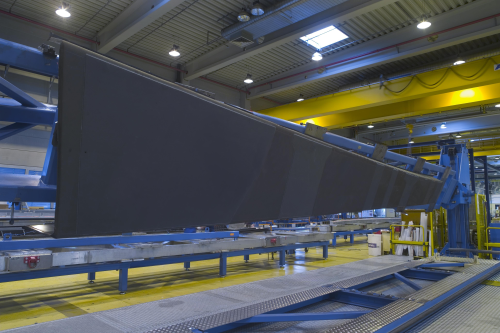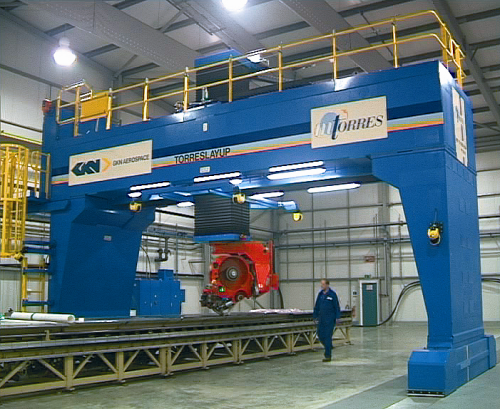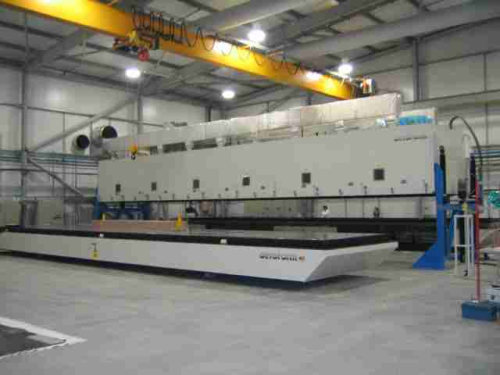


Boeing has established a new level of composites penetration in civil airliners with its 50% reinforced plastic B787 Dreamliner. However, Europe’s Airbus Industrie looks set to trump even this, albeit by a narrow margin, since its new A350 XWB (extra wide body), now in gestation, is advertised as being some 53% plastic. Practically all of the A350’s visible airframe – wings, fuselage, empennage, nacelles and control surfaces – will be very largely of carbon composite.
This is good news for the aerospace composites supply chain and good news for UK industry which, as long-time builder of Airbus wings, is to construct the extensively composite wings for all three variants of the A350, the -800, -900 and -1000. A major player in the wing build programme is GKN Aerospace, now installed on the site at Filton, near Bristol, that it acquired from Airbus in January 2009, with the aim of making it an acknowledged global centre for designing and building advanced wings for new-generation passenger jets.
Airbus was already building primarily metal wings for the full range of Airbus commercial aircraft in the UK. With the acquisition of the Airbus manufacturing operation at Filton, GKN Aerospace has inherited this work for the lives of the aircraft programmes concerned, and is adding the ability to produce composite wing assemblies.
Wing ambitions
GKN Aerospace needed new Europe-based facilities in order to achieve its wing ambitions. The chance to co-locate itself with Airbus UK (which retains the rest of the site) in a refurbished facility at Filton not only offered the space needed to assemble large A350 wing sections in parallel production streams able to turn out anything up to 14 aircraft sets per month, but also fitted in with its wider aim to produce wings for other new aircraft as well.
In line with the expected high composite content of those new-generation wings, the company is commissioning about now (early Spring), a new advanced composites production facility at Weston Approach, close to its major Filton site. This features the latest in production automation to meet airframer requirements for a continuous stream of wings that meet ever more stringent standards for aerodynamic efficiency, low weight and affordability.
Together, these two sites, along with its original facility at Cowes, Isle of Wight, UK, underpin GKN Aerospace’s drive to become an ‘advanced wing maker for the world,’ as Frank Bamford, senior vice president business development and strategy, puts it.
Bamford explains that the company is investing some $280 million over five years in its risk sharing partnership with Airbus to design and build the fixed trailing edge (FTE) section of the A350 wing. This comprises the fixed internal wing structure aft of the main wing box, but excluding the carbon wing skins, for which Airbus plants in Germany and Spain are responsible. The most significant part of the GKN Aerospace contribution is the rear spar, the crucial longitudinal strength member that forms the after edge of the central wing box and supports all the fixed sub-structures that carry the movable surfaces and, in the inboard portion, landing gear fixtures. The spar is subject to high loadings and stresses, a situation that favours composites with their high strength/low weight characteristics, tailorability and high fatigue tolerance.
Thorough material characterisation and painstaking design are pre-requisites for an optimum structure, of course, and GKN Aerospace can call on its extensive experience in engineering a wide range of composite items for aircraft including nacelles, flight control surfaces, cowls, ducts, engine fan blades and containment casings. It produces the primary composite wing spar for the Airbus A400M military airlifter and wing trailing edge sections for the world’s largest airliner, the Airbus A380. Not that its wing work is entirely Airbus focussed; it also produces the wing leading edge ice protection system for the B787, recently won a contract to build performance-enhancing composite winglets for Bombardier’s new C-Series airliner and also produces winglet structures for Aviation Partners-Boeing. Its sites in the USA manufacture wing spars for the Lockheed F22 fighter, airframe structures for unmanned air vehicles (UAVs) and parts for various business and light jets. All these components have substantial or majority composite content.
A350 wing
The Airbus-designed wing for the A350 wing is a largely composite assembly, though with ribs, internal frames and certain other sub-structures of metal. The wing’s beam strength derives from a central wing box in which two full-span spars form the forward and rear faces of the box. The spars have to be of carbon composite, both for weight saving and so that their coefficient of thermal expansion matches that of the wing’s carbon composite outer envelope.
GKN Aerospace is responsible for the rear spar and assembling it to all the fixed structure that attaches to it, these together comprising the fixed trailing edge (FTE). The composite spar, along with its attached structures, is produced in three 10 m sections that are joined for final checks before the full FTE is disassembled again for transportation to Airbus UK’s wing final assembly facility at Broughton, North Wales, where the complete wing is integrated.
The most substantial, inboard, FTE spar section weighs some 500 kg and includes the tough spar root with composite laminates up to some 25-30 mm thick. The mid-section, which has many attachment points, weighs about 150 kg, while the outboard section weighs 100 kg. Each spar section is produced by laying composite tows onto a large rotating mandrel, the formed part subsequently being autoclave cured under slight pressure. The spar tool is of Inconel metal and the mandrel for laying up spar sections is of carbon, in high modulus grade so that deflection is minimised. The mandrel concept contrasts with traditional metallic tooling philosophies, resulting in lighter, more affordable tooling.
Hexcel’s M21E pre-impregnated carbon/epoxy composite material, as specified by Airbus, is used throughout. Comprising a toughened epoxy resin reinforced with unidirectional carbon fibres, this system confers superior mechanical properties, in particular high impact resistance. Advanced 5-axis automated fibre placement (AFP) machines, purpose-designed and built by M. Torres in Spain, each wind 0.25-inch-wide tapes from up to 16 bobbins via a pulley system onto the rotating mandrel. Machines can be programmed to lay varying thicknesses of material onto the mandrels and can, for instance, build up thickness locally to provide integral pads for rib attachment points along the spar.
“AFP is part of our drive for a high level of automation so that we can efficiently produce wing sections to a consistent high quality while requiring as little manual work as possible,” comments chief engineer Chris Gear. “It will enable us to achieve high production rates so that we can meet our commitments as A350 production builds to a possible 14 aircraft a month. We’re also incorporating robotic drilling and machining and assembly.”
Interestingly, GKN Aerospace developed automatic tape laying (ATL) technology for its previous similar project, the spar for the A400M. (This is claimed to be the first major primary structure to be produced in carbon composite for the wing of a large transport aircraft).
ATL machinery at Cowes can lay up composite tapes 150 mm or 300 mm wide at the rate of about 18 kg (40 lb) of material per hour compared to hand lay-up rates of just 1-3 lb/hr for a similar item. For the A400M spar, the resulting flat laminate is then formed to the required ’C’ section spar shape over a heated tool, using a double-diaphragm press forming technique. The part is then put into an autoclave for final cure.
For the A350, however, automated fibre placement (AFP) is the preferred lay-up method. This is partly because the toughened resin used in the Hexcel M21E prepreg flows less readily than that in Cytec’s 977-2 used for the A400M spar, and partly because of the ability of AFP to produce more complex shapes. The A350 wing has significant curvature, particularly in the inboard sections where the profile is distinctly gull-winged. While ATL is viewed as excellent at producing large, reasonably flat structures, it can cause composite fibre buckling in more highly shaped components. AFP, on the other hand, while no better at laying up large flat surfaces, is accurate over more extreme curves and changes in direction because it uses narrower, independently controlled separate tapes to make up varying laminate thicknesses, including three-dimensional features.
Both methods enhance quality consistency and accuracy. ATL, for example, can produce the 14 m (45.9 ft) spars for the A400M wing to a dimensional tolerance of 0.5 mm. The metallic equivalent usually has to be adjusted during the build process. The method also enables the company to achieve void content as little as 1-1.5%, compared with 4% considered a more normal value for hand lay-up. AFP results in similar dimensional precision and laminate quality, while being potentially faster.
Essentially, each A350 spar section is layed on the mandrel, which is a long four-sided box, with cross-section, profile and wall thickness all varying according to location along the span. The AFP machine can lay two 10 m spars at one time, these subsequently being removed and placed onto a metal mould tool for curing in an autoclave.
Composite work takes place at the new Weston Approach facility near Filton in a 5000 m2 clean area. Two M. Torres winding machines are at one end of this space while a number of autoclaves plus ultrasonic testing and finishing facilities occupy the remainder. As production rate increases, more machines will be added in the clean room to cope with the volume.
At the time of a recent visit by Reinforced Plastics to Filton, GKN Aerospace had produced and evaluated a prototype composite spar for Airbus’ A350 wing box demonstrator and was preparing to embark on series production. The prototype milestone was achieved by a collaborative team comprising engineers from GKN Aerospace sites in Munich in Germany, Cowes and Filton, and utilised expertise gained at Cowes in manufacturing the A400M spars. Completed A350 production spars will be moved from the composites centre to the Filton assembly facility where they will be integrated with other fixed trailing edge components. Each FTE is assembled on a fixture, the spar section being placed therein hollow face up so that it can be drilled and machined as necessary, and the various ‘A’ frames, fitments and other structures can be attached.
Evolution
Chris Gear emphasises that the pace of composite manufacturing evolution is rapid, with significant changes being evident between successive generations of wing manufacture. Resin film infusion was developed for the Airbus A380 ‘superjumbo’ FTEs, designed by the company at the start of the millenium and in build from that time. ATL technology followed and went into production on the A400M spar in 2004. AFP is making its debut on the A350 FTE production line this year.
On the assembly side, another sign of evolution is the difference between the A380 and A350 programmes over the basic assembly method. In the A380 shop, the wing FTE remains fixed in position, on static jigs, requiring personnel and machines to move around the structure. On the more highly automated A350 line, however, there are no static jigs. Instead, FTE sections are moved on assembly jigs through a sequence of workstations where assembly, drilling, reaming and other machining operations are carried out robotically, to extremely tight tolerances. Flow line movement takes place on automatically guided vehicles (AGV), under the precise positional control needed to maintain overall wing geometry.
This change permits the faster assembly process needed to meet anticipated high production rates for the A350 wings. As Frank Bamford points out, both the A380 and A350 are remarkable for their large scale, but in the A380’s case this is in terms of sheer structure size, whereas for the A330 the scale is related to fabrication volume.
To win the A350 FTE work package, GKN Aerospace has had to develop its new fibre placement manufacturing process for a wing that is 50% greater in span, has the main landing gear attached to it and is much heavier than that of the A400M. Meeting production commitments called for high rates of material deposition onto the rotating spar mandrel along with further development of automated machining, spar and trailing edge tooling, flexible assembly, waterjet cutting of composites, single-step drilling and reaming of composites and inspection techniques. Methods for laying up, forming and processing the primary M21E composite material at speed had to be devised and refined. Modular tooling concepts had to be engineered so that tooling can adapt to the different component sizes required for the three aircraft variants.
Much of this technology has been developed at GKN Aerospace’s Composites Research Centre at Cowes on the Isle of Wight, though not without external assistance. Evolution has benefited from collaborative research, often supported by external funding.
“We are a builder and integrator of aerospace assemblies and have limited resources for research,” Chris Gear explains. “The R&D that we carry out is generally part-funded by GKN with support from the Government and other partners. We have engaged with a number of projects funded by the European Union and aimed at enhancing Europe’s competitive position in aerospace.”
For example, the Advanced Low-Cost Aircraft Structures (ALCAS) programme, funded as part of the EU’s sixth framework (FP6) research platform, helped the company to move on from the ‘black metal’ syndrome, characterised by designers simply substituting existing metal parts with carbon copies of the same thing, towards fully integral composite structures with much reduced part counts.
“Ideally, one would like to see a large composite structure infused as a single integrated whole in one hit,” declares Gear. “We‘re moving progressively towards this ideal.”
ALCAS, which resulted in a full-scale partial wing and some representative spars, itself built on the earlier FP5 Technology Application to the Near term business Goals and Objectives (TANGO) programme, which helped pave the way for more integrated airframe structures to be built in reinforced plastic materials. ALCAS supported development of technology underpinning the design and build of the complex composite spar for the A350.
The company has also taken part in the EU’s Aircraft Wing with Advanced Technology Operation (AWIATOR) research and is active on the Next-Generation Composite Wing (NGCW) programme, a £103 million UK initiative designed to keep Britain at the cutting edge of wing innovation and development. GKNA brings its composites manufacturing and ice protection capabilities to this latter programme, which is targeting high manufacturing rates and standards for future composite wings. Extending over three years from 2008, NGCW has helped the company optimise its factory layout for high-volume production and investigate new tooling developments.
Technology drive
As A350 production gets into its stride and progresses through the variants, GKN Aerospace will further refine its methods and processes. While it looks forward to a long continuation of its close partnership with Airbus, GKN Aerospace sees Filton as key also to opening doors into other future wing projects. In particular, it is targeting a share of the glittering prizes associated with next-generation single aisle (NGSA) aircraft, especially the yet-to-be designed types which, sometime late in this or early in the next decade, will start to replace the thousands of Boeing B737 and Airbus 320 jets that are the backbone of air transport today. GKN Aerospace aims to be airframer agnostic and hopes that its technology will appeal to both the established giants as well as regional aircraft builders like Bombardier and Embraer, plus up and coming aspirants like China’s Comarc.
To do this, it knows it will have to maintain the intensity of its technology drive, developing wings that improve still further on the state of the art represented by the A350 wing, itself the most efficient ever designed by Airbus. Wing design is likely, for instance, to benefit from laminar flow, an extremely smooth flow of air closely over the wing surface promoting maximum aerodynamic efficiency and lift. This will require the engineering of ultra-smooth composite wing skins, a fresh challenge for composite engineers. Future wings may evolve more towards a closed-cell, fully composite type of structure.
Efforts are on-going to achieve shorter composite manufacturing cycle times and cost reduction. One focus already yielding promising results is the use of microwave curing, with a view to reducing reliance on expensive and wasteful autoclaving methods. Such methods can also help bring about increased melding of parts by co-curing, so reducing part counts substantially. Further robotisation of machining and assembly operations should bring down the costs of volume production. Other developments will centre on effective integration of metals with composites since trends suggest that reinforced plastics will never entirely supersede metals and that the future lies in a creative partnership between the two.
Inclusion of sensing elements within composite laminates could assist the development of the ‘all-electric wing’, in which control surfaces are moved electrically rather than hydraulically. For example, sensors able to detect the formation of ice on leading edges could trigger de-ice heater mats.
GKN Aerospace is intimately involved with these and many other developments in its strategy, greatly facilitated by the Filton acquisition and the A350 FTE partnership, to be a very special Tier 1 supplier, a wing worker for the world in fact.
This feature will be published in the May/June 2010 issue of Reinforced Plastics magazine.






